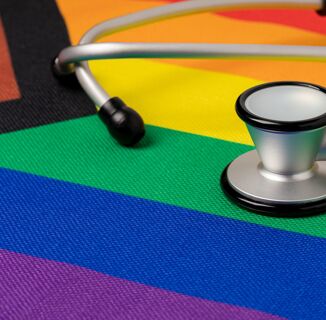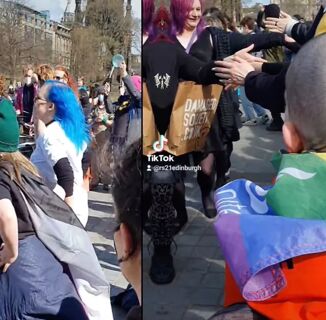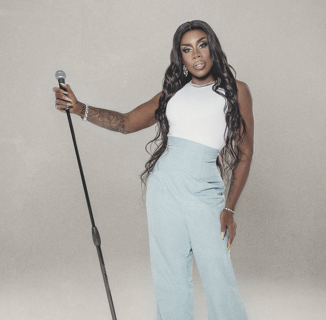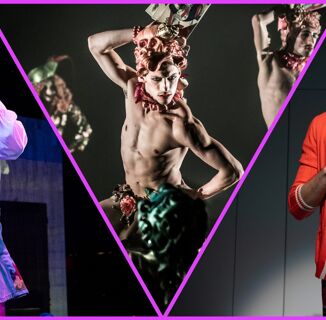In 1977, the year Harvey Milk made his historic run for the San Francisco Board of Supervisors, a New York Times reporter asked the firebrand activist why he, and several other gay men, were vying for political office.
“I’m thinking of that poor kid from San Antonio, growing up in the bars, hustling, on welfare,” Milk responded. “That 14-year-old from San Antonio needs us!”
Forty years on, a gay teen in south Texas still needs leaders like Milk. He just doesn’t have to journey to San Francisco to find them. This election cycle, Texas’ Democratic gubernatorial nominee, Lupe Valdez, as well as the Democratic candidate for Texas’ 23rd congressional district, Gina Ortiz Jones, are both lesbians. They’re among some 399 LGBTQ candidates running for political office across the U.S. on Tuesday, including four gubernatorial and twenty-two congressional nominees. Combined, they set a new record, according to the pro-equality political action committee Victory Fund.
Other records are shattering, too. Where once urban centers, mostly on the coasts, birthed America’s most prominent gay and lesbian politicians, now queer and trans political power is striding inland, out of the progressive cities and into the suburbs. LGBTQ congressional candidates in the country’s redder areas, states that Donald Trump won just two years ago, outnumber their blue-state counterparts this year, another first. The heartland is no longer a political no-man’s-land for gender and sexual minorities; it’s the frontline. Here, candidates are rewriting the playbook of queer politicking.
The field of LGBTQ candidates, across the country, has been growing for years. “It’s been building for decades,” says Sean Meloy, Senior Political Director at Victory Fund. “LGBTQ folks have been organizing to protect ourselves and protect our equality since even before Stonewall,” Meloy adds, citing the famous 1969 New York City riots often credited as the dawn of the LGBTQ rights movement.
Recent circumstance, though, has catalyzed this rise. Many LGBTQ candidates, including Texas congressional nominee Gina Ortiz Jones and Florida congressional nominee Lauren Baer, have credited their entrance into politics to the national turmoil of the past two years.
A former intelligence officer in the Air Force, Jones once concealed her lesbian identity for fear of retribution from her superiors. “For me, and for so many others who served under [Don’t Ask, Don’t Tell], it just reminds us that we are stronger when those ready and able to serve our country are afforded the opportunity to do so, especially as this administration works to make it more difficult for LGBTQ members to serve in the military,” Jones told Elle in August.
The explosion of LGBTQ candidates might be intrinsically entangled with a backlash against President Trump. “The anti-LGBTQ rhetoric coming from the White House as well as among conservative legislatures definitely is a factor in stepping up to run,” says Meloy. But it’s not the only reason. The piecemeal dismantling of the Affordable Care Act, the Republican omnibus tax bill, and the general pitch of national politics have stirred political newcomers to vie for public office.
The upswell of LGBTQ candidates, particularly in so-called Trump Country, dovetails with Democrats’ marathon drive to flip Congress and some state legislatures this election cycle. (Only one LGBTQ Republican, Hawaiian congressional nominee and Tulsi Gabbard opponent Brian Evans, has made it to the general — nearly all the 399 LGBTQ candidates are running as Democrats.) Key to this push are progressive college towns and suburbs around major American cities, where liberal enclaves begin to bleed into the countryside. For almost a decade, Republicans have maintained control of these purplish districts by harnessing the Obama-era conservative backlash (but also through gerrymandering). Now several GOP incumbents are facing defeat by the very people they once stigmatized.
“We’re sort of seeing the diffusion of LGBTQ candidates outward,” says Andrew Reynolds, a political science professor at UNC-Chapel Hill who has long studied the interplay of minority identities and electoral politics. “Whether in Kansas or Oklahoma or Texas, there are pockets of blueness where you might see LGBTQ candidates elected.”
These elections don’t look all too different from those of LGBTQ candidates in, say, Connecticut or southern California. There’s the usual bit of fundraising, as well as the speaking circuit. Nominees will seek endorsements and give stump speeches. Gone are the days when a candidate ran on an expressly “gay” protest platform, as Harvey Milk once put it, or hid their identity altogether. Today, most candidates treat their sexuality and gender as non-issues. Electorates usually respond in kind, regardless of where they are in the country.
To be sure, there are moments when intolerance still enters the race. A Republican precinct committeeman in Kansas, Michael Kalny, resigned early last month after he took to social media to lash out at Sharice Davids, a Democrat running in Kansas’ 3rd congressional district. In a private Facebook message to the president of a Democratic women’s group, Kalny wrote “your radical socialist kick boxing [sic.] lesbian Indian will be sent back packing to the reservation.” Davids is a member of the Ho-Chunk Nation, a Native American tribe in Wisconsin. In an October 10 statement to USA Today, Davids responded to the ugly remarks, saying: “This message doesn’t represent Kansas values, and it doesn’t represent the values of the Republicans we know, many who support this campaign.”
The bigoted episode illustrates how LGBTQ candidates, particularly in redder parts of the country, are reshaping politicking while queer. Unlike queer political organizers of the past, particularly during the AIDS epidemic, LGBTQ candidates don’t make their sexuality and gender a topic of conversation — that is, not unless their opponents want it to be.
Everyone I spoke to while reporting this story pointed to Danica Roem as an example of this strategy. Last year, Roem made history by becoming the first transgender person to be elected to a state legislature anywhere in the country. Her opponent was the incumbent to the Virginia House of Delegates, Robert G. Marshall, a transphobic Republican and author of the state’s controversial “bathroom bill.”
“Danica Roem ran the model campaign,” Reynolds told me in a phone interview. “She allowed the opponent to lead with his transphobic comments, and she just garnered all the sympathy. Her opponent looked like a dinosaur. He was just mean, unsympathetic, unempathetic.” Her campaign, in other words, was an exercise in composure; she led in the polls by following the cues of the other side. A similar strategy appears to be working for Democrats elsewhere.
Meloy, who has worked for Democratic congressional campaigns in more conservative districts of Pennsylvania and Virginia, sees another reason why LGBTQ contenders may fare well in redder places. Voters, he believes, are looking for a candidate who feels genuine and sincere. “Voters want authenticity. Although there is still a stigma against LGBTQ people, when a candidate is out, it’s a benefit to voters. They think, if you’re willing to be open about that, you will be able to fight for me and tell me the truth,” says Meloy.
Misty Snow agrees. In 2016, Snow went from political obscurity to the primetime chyrons overnight, after she defeated a self-branded ‘conservative’ Democrat in Utah’s U.S. Senate primary. With this win, she became the first trans person to clinch a major-party nomination for Congress’ upper chamber. Although she eventually lost to Republican incumbent Mike Lee — whose seat hasn’t been in Democrats’ hands since 1951 — Snow garnered more votes statewide than Hillary Clinton. In fact, she outperformed Clinton in 20 out of crimson Utah’s 29 counties.
When asked to speculate on her performance relative to the former Secretary of State, Snow says that Clinton failed to communicate a meaningful platform to Utahns. Voters care about healthcare, the economy, and education, she tells INTO. Her own gender was negligible. She remembers once meeting a young Republican man while canvassing in Salt Lake City. Far from enemies, they bonded over their shared lack of formal, post-secondary education.
Snow recalls the young Republican voter saying: “‘You don’t have a college degree? I don’t have one, too!’” Most people, she added, can rise above quibbling over a stranger’s gender and sexuality. The message, the political platform, is more important than the person who bears it.
Snow’s platform centered on protecting Utah’s nature reserves and alleviating economic burdens, like the high costs of healthcare and higher education, issues that matter to straight and cisgender folks as well as LGBTQ Utahns. When so often the most vulnerable populations reside in rural and red-state America, LGBTQ candidates there can bring together coalitions of unlikely allies. This effort sometimes means downplaying their own sexual and gender identities. But when a gay legislator votes to expand Medicaid, trans people of lesser means can access hormone therapies. And when a trans man sits on a state school board, he can safeguard curricula from LGBTQ erasure, and protect trans students from being forced to use restrooms and locker rooms that match their sex at birth rather than their current gender.
Of course, Misty Snow and Sharice Davids and Gina Ortiz Jones aren’t your granddad’s idea of a Democrat. But they don’t practice Harvey Milk’s uncompromising, self-professed “gay politics” either. LGBTQ politics is evolving. Its geography is spreading; its timber is staid.
If, on Tuesday, a Democratic ‘Blue Wave’ comes crashing down on Congress and state legislatures, Meloy and Reynolds and many others hope it will also carry a few more LGBTQ leaders to shore. The change may be incremental. But when only .01 percent of public officeholders are LGBTQ, any change is good.
It’s an evolution that Harvey Milk couldn’t have anticipated forty years ago. When once queer folks in rural, religious, red-blooded America looked toward San Francisco and other progressive bastions for political leadership, more and more everyone else should be tuning into them.
Help make sure LGBTQ+ stories are being told...
We can't rely on mainstream media to tell our stories. That's why we don't lock our articles behind a paywall. Will you support our mission with a contribution today?
Cancel anytime · Proudly LGBTQ+ owned and operated
Read More in Impact
The Latest on INTO
Subscribe to get a twice-weekly dose of queer news, updates, and insights from the INTO team.
in Your Inbox













